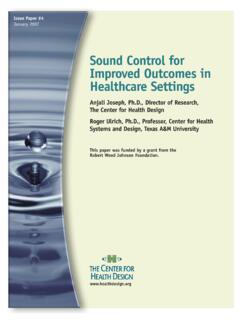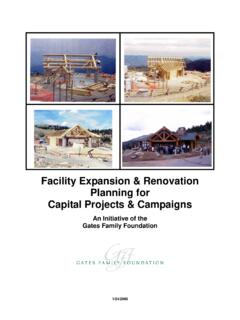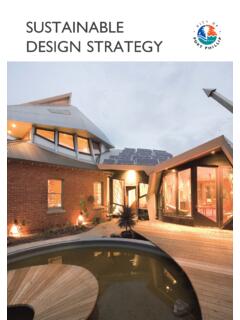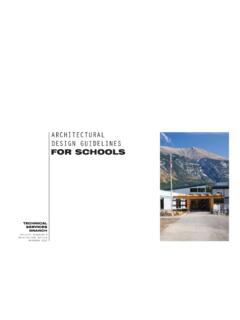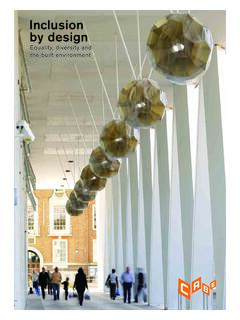Transcription of Evidence-Based Design
1 Evidence-Based Design I Evidence-Based Design I The built environment is a powerful force in patient care. If properly designed, it enables care providers to do their work more effectively, and it has the potential to enhance patient safety. However, it s not a standalone. There is a continuous interplay between a building, its layout, and the work that is carried on within the walls. The workflow and care-delivery processes and the choreography of patients as they interact with the building and the caregivers must be in harmony. Aspects of this are discussed throughout this book in various chapters.
2 One can look at Evidence-Based Design (EBD) in a narrow context as focusing only on research affecting the built environment or, in a more expansive context, as research coming from the neurosciences or lean Design or a number of healthcare system research initiatives designed to improve patient outcomes. Design is a term that can be applied to care processes, architecture, the act of crafting the experience for patients as they interface with the medical center, or one can Design a guest-relations program. This is a time for great optimism. Never, in the past 30 years, have so many individuals, organizations, and regulatory agencies focused so intently on improving both the physical environment for patients as well as aspects of patient Design1 Oncology Clinic Corridor | Rebecca and John Moores Cancer CenterUC San Diego Medical Center, La Jolla, CA.
3 Zimmer Gunsul Frasca Partnership. Photography: Robert CanfieldEvidence- based Design I 3 I A Visual Reference for Evidence-Based DesignEvidence- based Design I 3 The Four Levels of Evidence-Based PracticeHamilton (2003) identifies four levels of Evidence-Based practice, each successive level requiring more rigor and commitment. Level-one practitionersThese practitioners stay current on literature in the field and interpret the meaning of evidence as it relates to the project at hand. They are learning from others as well as developing new examples for practitionersThese practitioners take another step by hypothesizing the expected outcomes of Design interventions and plan to subsequently measure the results.
4 In this case, the Design is less subjective and more challenging. The designer must understand the research and be able to interpret its implications and then be able to logically connect the Design decision to an outcome that can be measured. This reduces the number of arbitrary Design decisions and delivers solutions linked to outcomes. The designer must be prepared, however, to accurately report the findings regardless of whether successful or not. Sometimes there will be other discoveries that come out of this process in addition to the hypothesis being practitionersNot only do these practitioners keep current with the literature, create hypotheses about intended outcomes, and measure results, they also report or publish their findings publicly.
5 This may include speaking at confer-ences or getting articles published. This invites the scrutiny and possible criticism of others who may disagree with the findings and subsequently may lead the practitioner to become more rigorous in his or her approach. Or a designer may collaborate with a researcher to derive the benefit of working with someone who under-stands qualitative and quantitative research practitionersThese practitioners follow all of the steps previously mentioned but then attempt to get the research pub-lished in peer-reviewed journals.
6 This generally requires that a Design professional collaborate with scholars in academic or professional settings who understand the rigor of what is required to get an article accepted by a journal. This is the type of research that advances the field of labels level-zero practitioners as those individuals who understand the notion of EBD, but limit their study to isolated comments from magazine articles or conference presentations, using them subjectively to support their Design , then claiming that the Design is Evidence-Based . Without hypotheses and measure-ment, these individuals complete a project and search for positive outcomes.
7 Since there was never a hypoth-esis, the necessary causal relationship is missing, thus, it s not IS Evidence-Based Design ?The Center for Health Design (CHD) defines EBD as the deliberate attempt to base building decisions on the best available research evidence with the goal of improving outcomes and of continuing to monitor the success or failure for subsequent decision-making. An Evidence-Based model can be used for all Design deci-sions. A report published by CHD (Ulrich et al. 2004) is a foundation for EBD. Some 650 studies (actually more than 1,000 in the current compilation) published in peer-reviewed journals can be sorted into three broad categories: safety, reduction of stress, and ecological health.
8 (A separate abstracts table is available at the CHD website at ) Although most of the recent evidence has come from patient safety and clinical outcomes, sources of evidence may come from widely varying domains including organizational and financial performance. In some respects, it can be said that the concept of healing environments has evolved into EBD, but it s mainly in the area of reduction of stress that this overlap occurs. Research that underpins the concept of a healing or psychologically supportive environment is drawn from the neurosciences, evolutionary biology, psychoneu-roimmunology (the effect of the emotions on the immune system), and environmental psychology.
9 Some of these studies are part of the EBD report (Ulrich et al. 2004), but EBD goes beyond the healing environments dimension to consider the effect of the built environment on patient clinical outcomes in the areas of staff stress and fatigue, patient stress, and facility operational efficiency and productivity to improve quality and patient Design CertificationImplementation of EBD requires that Design professionals, healthcare planners, and healthcare organization management teams be familiar with the process to follow to identify research; create hypotheses; gather, imple-ment, and report the data associated with their projects.
10 To this end, CHD is inaugurating, early in 2008, a credentialing program called Evidence-Based Design Assessment and Certification (EDAC). This will help healthcare organizations identify knowledgeable, certified practitioners. Once accredited, an individual will have an obligation to employ an EBD process in his or her components of EDAC certification include:1. Meaningful collaboration with the client/users2. Recognizing and responding to the unique context of each project3. Using best available credible evidence from a variety of sources4.
